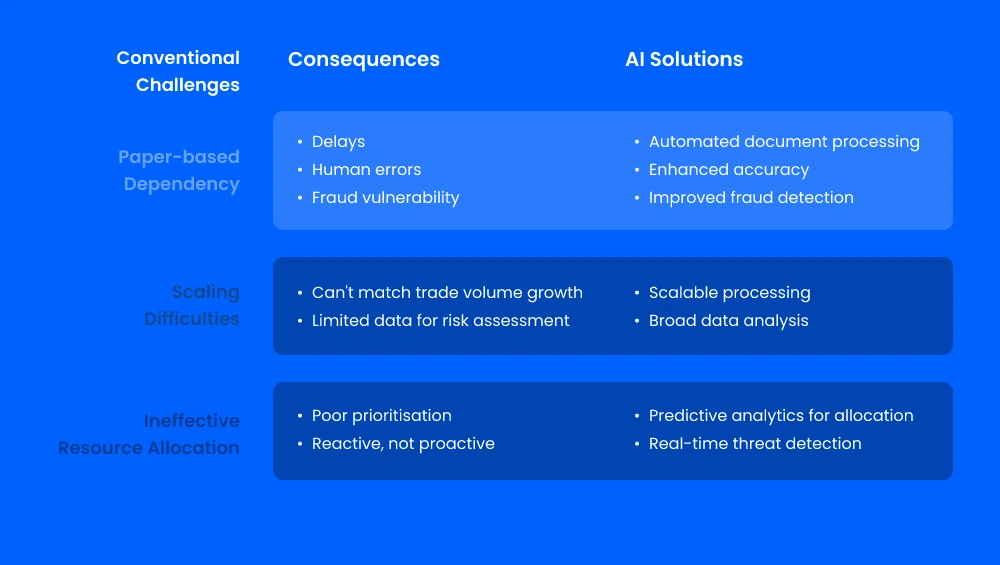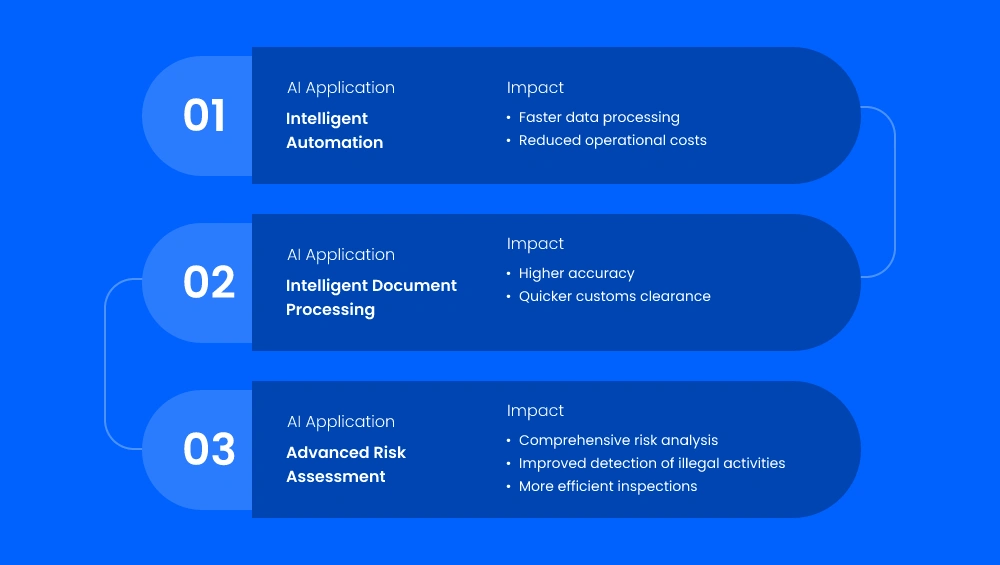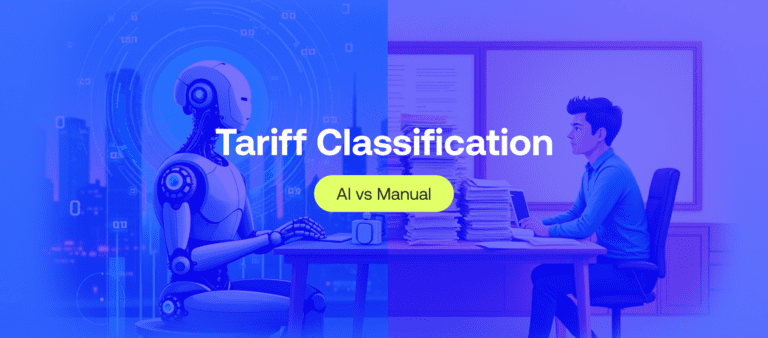Fast & Accurate ENS GB & EU ICS2 Solutions Built for You.
Future of Customs: The Role of AI in Border Security
-
Freya Jane
- Director of Customer's Success
The complexity of safeguarding modern borders poses increasing obstacles. Increasing numbers of international trade, a variety of cargo kinds, and changing security risks necessitate increasingly advanced and effective solutions. Artificial intelligence (AI) is emerging as a revolutionary force that has the potential to change customs and border security procedures completely. This blog examines the role of AI and intelligent document processing in international trade and border security.
The failures and inefficiencies of conventional trade and customs procedures

Customs and trade operations in the modern world still mostly rely on manual procedures, which are sometimes tedious and time-consuming. Below, we will shed light on the fundamental drawbacks of these conventional approaches and open the door to understanding how revolutionary artificial intelligence (AI) could be in promoting safe and efficient international trade.
1. Paper-based dependency and its drawbacks
Trade businesses have traditionally used a paper-heavy strategy, requiring the human evaluation and verification of several physical documents such as cargo manifests, customs declarations, and travel documents. This procedure, which involves physical inspections, cross-referencing, and repetitive data entering, is essentially problematic because of the following:
- Inefficiencies and delays: Processing delays for both legal and potentially illegal freight rise dramatically, resulting in long lineups, logistical obstacles, and missed deadlines. These delays have a detrimental effect on economic activity, the competitiveness of international commerce, and the quick flow of commodities.
- Susceptibility to human mistakes: Data input, document interpretation, and risk assessments are all susceptible to errors due to human exhaustion, complicated legislation, and the sheer amount of papers handled. These mistakes can have serious consequences, ranging from needless inspections and delays for traders who comply to the possibility of missing real risks, jeopardising productivity and security.
- Restricted visibility and fraud vulnerability: The dependence on physical documents limits access to important data that could be obtained from other sources, like social media activity, trade intelligence, and financial transactions. This narrow scope makes it difficult to completely analyse risks and recognise fraudulent operations, creating gaps for criminals to exploit.
2. Information access restrictions and scaling difficulties
The existing system struggles to appropriately meet the dynamic nature of global commerce, as defined by:
- Exponential growth: Manual methods are unable to keep up with the continual rise in global trade volumes. This leads to overburdened customs personnel, longer wait times, and possible bottlenecks that impede the smooth flow of lawful trade.
- Limited information scope: Traditional approaches rely mostly on information directly supplied by dealers and passengers, which is frequently limited to physical document content. This narrow scope makes it more difficult to carry out thorough risk assessments and spot any abnormalities or hidden trends that could point to illegal activities.
3. Ineffective resource allocation and missed opportunities
The following results from manual processes’ limitations:
- Poor resource allocation: Due to inadequate information, workers are compelled to prioritise, potentially overlooking high-risk scenarios, while low-risk shipments experience excessive delays, resulting in poor resource allocation and missed opportunities to intercept unlawful activity.
- Lack of proactive intelligence and prevention: Traditional approaches’ reactive nature restricts their capacity to gather intelligence proactively and execute preventative measures, potentially allowing threats to slip through the cracks and inflict harm once they emerge.

Buried in manual customs procedures?
Stop wasting time on manual processing & automate with CDS!
AI-powered revolution: Role of AI in streamlining trade and customs processes

Artificial intelligence (AI) offers a comprehensive solution to the previously mentioned limitations, providing a revolutionary chance to improve and expedite conventional trade and customs procedures. Let’s examine the possible effects of these major artificial intelligence applications:
1. Intelligent automation: Unlocking efficiency
Repetitive duties, including document processing, risk assessment, and anomaly identification, frequently dominate customs operations. These domains no longer require manual intervention thanks to AI-powered process automation, which has several important advantages:
- Increased efficiency: Automation enables the speedy processing of large amounts of data, drastically lowering clearing periods for legal trades. This allows customs officials to focus their efforts on products that pose a higher risk and more intricate investigations.
- Faster clearance times: Intelligent document automation facilitates faster clearance times for compliant traders by streamlining document processing and automating risk assessments. This reduces delays and promotes smoother cross-border trading.
- Decreased operational costs: Customs agencies can save a lot of money by automating administrative activities, which also minimises the need for human resources and simplifies workflows.
2. Intelligent document processing automation: Enhanced precision and speed
One of the main challenges in conventional customs operations is the extraction and interpretation of data from complicated documents such as cargo manifests, invoices, and travel papers. Intelligent workflow automation driven by AI overcomes this challenge via:
- Improved accuracy: AI systems are very skilled in reliably extracting data from a wide range of document formats, reducing the possibility of human mistakes and inconsistent data that might cause delays and errors.
- Enhanced speed: AI dramatically cuts processing times, simplifies customs procedures and enhances overall efficiency. This is accomplished by automating data extraction and interpretation.
- Increased data quality: Accurate and precise data extraction guarantees better-quality information input for risk analyses and other analytical procedures.
3. Advanced risk assessment: Trade facilitated, security strengthened
Traditional risk assessments frequently depend on limited data and laborious analysis, which may cause them to miss crucial information. AI provides a sophisticated method that allows for:
- Comprehensive analysis: AI is capable of analysing enormous volumes of data from sources such as travel patterns, financial transactions, trade history, and other pertinent areas to create a more complete picture of possible hazards.
- Better detection: AI’s capacity to spot intricate patterns and abnormalities makes it possible to find sophisticated smuggling operations and other illegal activities that would escape detection by traditional methods.
- Targeted inspections: AI enables focused inspections, avoiding interruptions to lawful trade flow and maximising resource allocation by more accurately detecting high-risk goods.
Let our AI-driven IDP automate customs procedures and expedite trading! Start Now!
Future of intelligent automation: Transforming customs and trade landscape
The ongoing development of AI has given rise to several new technologies that have the potential to completely transform trade and customs procedures. Let’s explore a few fascinating options and recognise any obstacles that would need to be overcome for responsible implementation:
- Advanced Machine Learning: By continually improving risk assessment models through training on large datasets, machine learning algorithms may more precisely target high-risk activities and minimise interruptions to lawful commerce.
These new technologies have a great deal of potential to improve trade facilitation and border security even further.
The bottom line
AI is a revolutionary force that will change the way customs and commerce are carried out in the future. We can usher in a new age of prosperity and collaboration by using its capacity for more effectiveness, better security, and easier global trade facilitation. However, navigating this path necessitates dedication to responsible implementation, resolving ethical concerns, protecting data security, and training the workforce for this significant transition. The future of customs is here, and it is powered by AI, promising a border management ecosystem that is more secure, efficient, and adaptive to the changing dynamics of global trade and security threats.
Ready to use cutting-edge AI technology to transform your border security and customs operations? iCustoms is leading this change with IDP, our AI-powered software that improves border security for global trade while streamlining customs documentation. Embrace the future of customs administration with a system that ensures efficiency, compliance, and security across your trading procedures.
Don’t let out-of-date procedures slow down your business. Find out how iCustoms can help your business handle the challenges of doing business internationally with confidence and comfort. Go to our website to find out more about IDP and arrange a demo. With iCustoms, you can transform your customs processes and move towards a more efficient and secure future.

Tired of spending hours on manual customs procedures?
Let iCDS automate it for you, ensuring faster processing!
FAQ's
How can we use AI in Customs?
AI can be used at customs to automate regular processes such as document processing, risk evaluation, and identifying anomalies, therefore increasing efficiency and accuracy.AI can be used at customs to automate regular processes such as document processing, risk evaluation, and identifying anomalies, therefore increasing efficiency and accuracy.
How does the power of artificial intelligence impact Customs operations?
AI improves customs operations by speeding up procedures, decreasing mistakes, and allowing for improved risk management via data analysis and automation.
How does AI contribute to improving border security operations?
AI helps border security by allowing for better risk assessment, detection of suspicious activity, and faster and more accurate threat identification.
Can AI adapt to evolving threats and challenges in customs and border security?
Indeed, AI is capable of adapting to changing dangers by continually learning from fresh data, identifying trends, and updating algorithms to successfully handle emerging issues.
You may also like:
Ready to streamline your Customs Declaration Process?
Boost efficiency, reduce errors, and ensure accuracy with iCDS
Subscribe to our Newsletter
About iCustoms
Ready to streamline your Customs Declaration Process?
Boost efficiency, reduce errors, and ensure accuracy with iCDS

